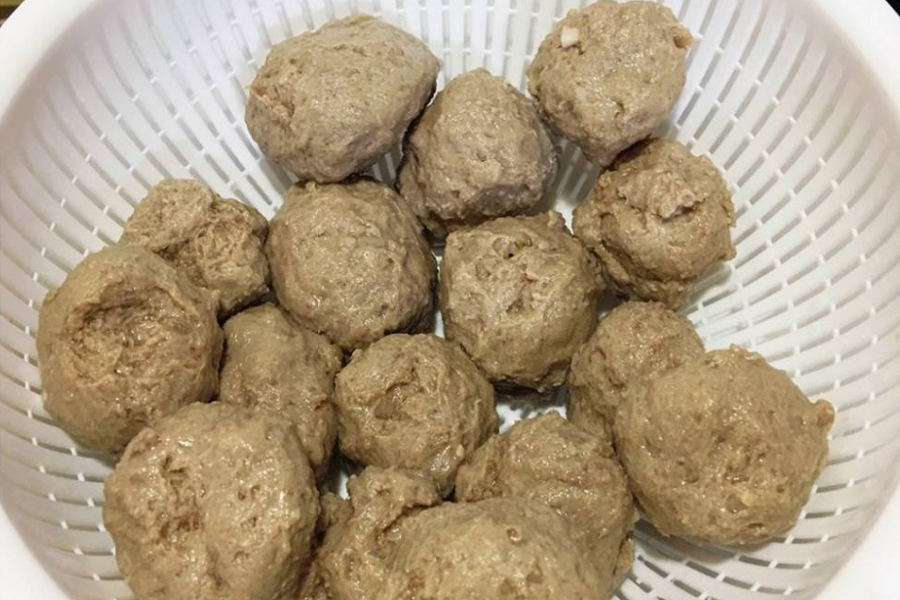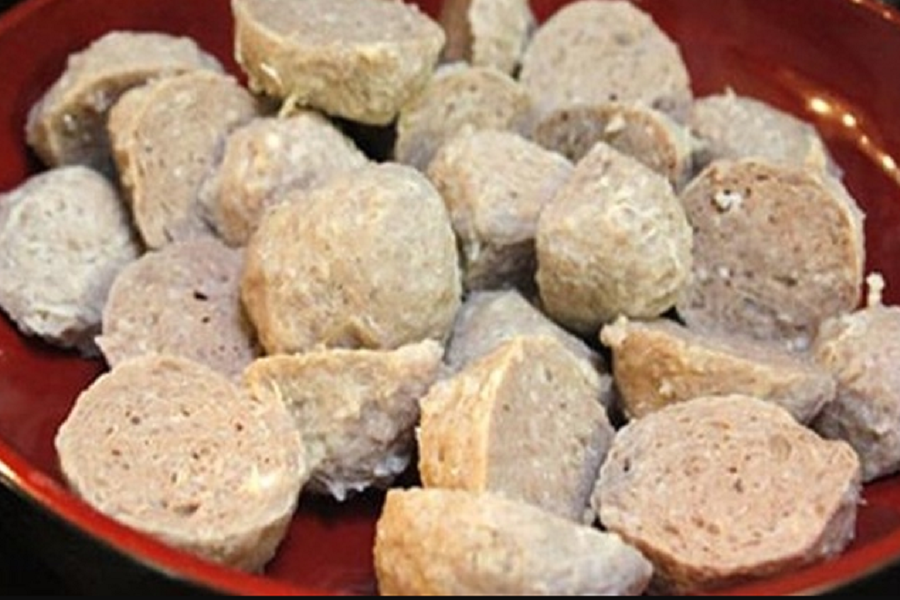Tin tức
Beef balls
Beef balls are a versatile culinary creation that holds significant cultural value across various cuisines worldwide. These flavorful morsels, typically made from ground beef seasoned with a blend of spices, showcase the ingenuity and diversity of food preparation methods. From Asian noodle soups to Western barbecue dishes, beef balls serve as a delightful addition to many meals, illustrating how this simple ingredient can transcend borders and traditions.
Introduction to Beef Balls
The preparation of Beef balls can vary greatly depending on regional preferences. For instance, in Italian cuisine, they are often incorporated into hearty marinara sauces, while in Asian cuisines, they may appear in broths or stir-fried dishes, highlighting their adaptability. Their popularity as both snacks and main courses underscores their deliciously juicy nature, making them a favourite among food enthusiasts and home cooks alike. Served as appetizers during gatherings or featured prominently in family meals, beef balls can be enjoyed in myriad ways, leaving a lasting impression on palates.
This blog post will delve deeper into the world of beef balls, exploring their history, various preparation methods, and gourmet recipes that elevate them beyond simple comfort food. We will discuss how to select the best cuts of beef, the art of seasoning, and innovative cooking techniques that contribute to the juiciness and flavor of these meatballs. Whether you are looking to serve them as a primary dish or a tantalizing appetizer, beef balls can easily be transformed into a gourmet delight. Join us on this culinary journey as we unlock the full potential of these delectable bites.

Ingredients: What Makes Perfect Beef Balls
Creating delightful beef balls begins with selecting the right ingredients, which play a crucial role in determining the flavor and texture of the final dish. The cornerstone of any beef ball recipe is the type of meat used. While ground beef is the most common choice, different cuts can significantly enhance the overall taste. For instance, a mixture of ground chuck, which is rich in fat, combined with brisket or sirloin can yield a tender and flavorful result. The fat content in the meat ensures that the beef balls remain juicy when cooked.
In addition to the beef, various spices and herbs contribute to the flavor profile of the beef balls. Common spices include garlic powder, onion powder, salt, and pepper, which provide a solid foundation. Fresh herbs like parsley, basil, or rosemary can add a vibrant touch and complement the beef’s richness. The balance of these seasonings is integral, as too much can overpower the meat, while too little may leave the beef balls bland.
Optional ingredients can further elevate the dish. Incorporating grated cheese, such as Parmesan or mozzarella, adds a creamy texture and enhances the overall flavor. For those looking to introduce more nutrients, finely chopped vegetables like onions, bell peppers, or carrots can increase moisture and contribute a subtle sweetness to the beef balls. When selecting these ingredients, quality is paramount. Always opt for fresh herbs and high-quality, grass-fed beef when possible to ensure a superior taste and texture.
In summary, the perfect beef balls result from a thoughtful combination of quality meat, well-balanced spices, and optional enhancements. By paying close attention to these ingredients, home cooks can create an ever-delicious culinary experience.
Popular Cooking Techniques for Beef Balls
Preparing deliciously juicy beef balls can be achieved through several cooking techniques, each offering unique advantages and flavor profiles. The most common methods include frying, baking, grilling, and boiling, and each has its merits and drawbacks.
Frying is a popular choice for achieving a crispy outer layer while maintaining a succulent center. In this method, beef balls are usually cooked in hot oil, which creates a rich flavor and appealing texture. However, frying can also add excessive oil and calories, making it less ideal for those seeking a healthier cooking option. Furthermore, achieving the right balance of heat is crucial to prevent the beef balls from burning or remaining undercooked.
Baking presents a healthier alternative, as it does not require additional oil. By placing beef balls in a preheated oven, they can cook evenly, resulting in a tender texture. Baked beef balls can also be easily seasoned and flavored with herbs or sauces, making them versatile for various recipes. On the downside, baking may not provide the same depth of flavor that frying offers, and the texture may be softer than desired.
Grilling is another excellent method for cooking beef balls, imparting a smoky flavor and creating beautiful grill marks. This technique works particularly well when using a grill or griddle, allowing the excess fat to drain away. However, care must be taken to prevent overcooking, as the high heat from grilling can lead to dry beef balls if left unattended. Additionally, grilling requires outdoor space or specialized indoor equipment.
Boiling is perhaps the simplest method, best suited for those looking to incorporate beef balls in soups or stews. While this technique offers convenience, it can lead to a loss of flavor, as the beef balls may soak up surrounding liquids. Thus, it is generally recommended to use boiling as a preparatory step rather than the final cooking method.
In conclusion, the choice of cooking method depends largely on personal preferences and the specific dish being prepared. Each technique has its strengths and weaknesses, so it is essential to choose a method that aligns with desired outcomes and flavor profiles.
Flavor Enhancements: Spices and Seasonings
Enhancing the flavor of beef balls involves an artful combination of spices and seasonings that tantalize the palate. Different cultures around the world have their own unique approaches to seasoning beef, which can elevate these culinary delights to new heights. For instance, traditional Italian cuisine often incorporates garlic, oregano, and Parmesan cheese, creating a wholesome flavor that pairs beautifully with marinara sauce. In contrast, Middle Eastern recipes frequently utilize spices such as cumin, coriander, and allspice, resulting in a warm, aromatic essence that permeates the beef, making it irresistible.
Exploring contemporary flavor combinations can also yield exciting results. For example, blending Asian-inspired ingredients like ginger, soy sauce, and sesame oil into a marinade can yield a sweet and savory profile, perfect for beef balls served on skewers. Another modern approach is to experiment with spices like smoked paprika and chili powder to introduce a depth of smokiness and heat, providing a delightful contrast to the richness of the meat.
To simplify the seasoning process, consider creating your own seasoning mixes. A versatile blend could consist of salt, black pepper, garlic powder, onion powder, and dried herbs like thyme or rosemary. These ingredients not only enhance the overall flavor but also complement the natural juices of the beef. Marinades can also be effective in infusing flavor; a mixture of olive oil, vinegar, garlic, and herbs can create a tender and flavorful base for your beef balls.
Furthermore, accompanying sauces can amplify the experience. Consider rich sauces made from tomato, wine, or even a spicy sriracha blend. These enhancements ensure that every bite is a satisfying journey through a spectrum of flavors, illustrating the diverse culinary possibilities one can achieve with beef balls. Each seasoning choice is an opportunity to craft a personalized dish that reflects our tastes and preferences.
How to Make Beef Balls: Step-by-Step Recipe
Creating delicious and juicy beef balls at home is an enjoyable culinary experience. This recipe offers a straightforward guide, with a focus on quality ingredients and techniques to enhance flavor and texture. For this classic beef ball recipe, you will need the following ingredients:
- 1 pound ground beef (preferably 80% lean, 20% fat)
- 1/2 cup breadcrumbs
- 1/4 cup grated Parmesan cheese
- 1/4 cup chopped fresh parsley
- 2 cloves garlic, minced
- 1 large egg
- 1 teaspoon onion powder
- 1/2 teaspoon black pepper
- 1 teaspoon salt
- 1/4 teaspoon red pepper flakes (optional, for extra heat)
- Cooking oil for frying
To begin, place the ground beef in a large mixing bowl. Add the breadcrumbs, Parmesan cheese, parsley, minced garlic, egg, onion powder, black pepper, salt, and red pepper flakes if desired. Using your hands, mix the ingredients until they are well combined, but avoid over-mixing, as this can make the beef balls tough.
Once mixed, form the mixture into small balls, roughly one to one-and-a-half inches in diameter. This should yield about 12-15 beef balls, depending on the size you choose. As you shape the beef balls, consider adjusting the size to your personal preference or dietary needs.
Next, heat a large skillet over medium heat and add a tablespoon of cooking oil. Carefully place the beef balls in the skillet, ensuring that they are not overcrowded. Fry the beef balls for approximately 5-7 minutes on each side, or until they are golden brown and cooked through, reaching an internal temperature of 160°F.
Once cooked, transfer the beef balls to a paper towel-lined plate to absorb excess oil. You can serve these flavorful beef balls in various ways—over pasta, in a sub sandwich, or as part of a stir-fry—allowing for generous experimentation to suit different tastes and dietary preferences.
Serving Suggestions: Pairings and Sauces
Beef balls are a versatile dish that can be served in numerous ways to complement various dining preferences. The key to elevating the flavor of beef balls lies in the thoughtful selection of sauces, sides, and dips that enhance their juicy and savory profile.
When considering sides, rice is an excellent complement, providing a neutral base that allows the rich flavors of the beef balls to shine. A fragrant jasmine or basmati rice can pair beautifully with beef balls, especially when served with a sauce that adds a hint of sweetness or spice. Pasta dishes, such as spaghetti or penne, also make a fantastic backdrop, particularly when slathered in a robust tomato sauce that contrasts with the meatiness of the beef balls.
For a lighter touch, fresh salads can balance the richness of the beef. A simple arugula and cherry tomato salad drizzled with a balsamic vinaigrette can enhance the dining experience. Alternatively, crusty bread is an ideal accompaniment for soaking up any remaining delicious sauce, adding both texture and heartiness to the meal.
In terms of sauces, the options are plentiful. A classic tomato sauce, simmered with fresh herbs and garlic, pairs seamlessly with beef balls, creating a comforting dish reminiscent of Italian flavors. For those seeking an Asian twist, teriyaki sauce offers a sweet and tangy glaze, beautifully complementing the savory taste of the beef. Lastly, spicy dipping sauces, such as a sriracha or a garlic aioli, provide an exciting kick that can cater to diverse palate preferences.
By carefully selecting these pairings and sauces, beef balls can be transformed into a culinary delight that appeals to a wide audience, ensuring a pleasurable dining experience.
Beef Balls Around the World: Regional Variations
Beef balls have transcended geographical boundaries, evolving into a beloved culinary staple across various cultures. Each region has its unique twist on this dish, showcasing local ingredients and cooking methods that offer an intriguing tapestry of flavors and textures. In China, for instance, beef balls are often characterized by their bouncy texture, achieved through the use of finely minced beef mixed with starch. These versatile meatballs, known as “nǐngròu wán,” are typically served in hot pot or as part of a noodle soup, embodying the essence of communal dining and shareable dishes.
Traveling westward to Italy, the traditional meatball, or “polpetta,” stands out with its rich blend of ground beef, breadcrumbs, and herbs. Often simmered in rich tomato sauce, Italian beef balls are commonly paired with pasta or served in subs, exuding comfort and nostalgia. The addition of Parmesan cheese or fresh basil enhances the flavor profile, illustrating the country’s emphasis on fresh ingredients and bold tastes.
In Scandinavian kitchens, Swedish meatballs, or “köttbullar,” differ significantly in flavor and composition. Typically smaller and served with cream sauce and lingonberry jam, these beef balls are a staple of Swedish cuisine. Their savory and slightly sweet profile reflects the region’s agricultural practices and preference for hearty, filling meals.
Middle Eastern variations of beef balls, known as “kibbeh,” feature a captivating combination of spices, bulgur wheat, and minced meat, shaped into torpedo-like forms. Often baked or fried, these beef balls highlight the fragrant use of spices such as cumin and coriander, mirroring the region’s culinary diversity and its ability to blend flavors innovatively.
The regional variations of beef balls illustrate not only the versatility of this dish but also the creative possibilities that exist across different cultures, celebrating culinary heritage through diverse ingredients and cooking techniques.
Health Considerations: Nutrition and Alternatives
Beef balls are not only a culinary delight but also an intriguing subject from a nutritional standpoint. One of the primary considerations when enjoying beef balls is their calorie content and protein levels. Typically, a serving of traditional beef meatballs contains approximately 200-300 calories, with protein comprising a significant percentage of this composition. Lean beef, for instance, provides an excellent source of high-quality protein, which is vital for muscle repair, hormone production, and overall bodily function. Furthermore, lean beef is rich in essential nutrients such as iron, zinc, and B vitamins, contributing to improved immune function and energy metabolism.
However, those mindful of dietary intake may seek alternatives to traditional beef balls, particularly if aiming to reduce fatty content or consume plant-based options. Ground turkey and chicken, for instance, have emerged as popular substitutes, providing a lower calorie and fat option while still maintaining a comparable protein level. A typical serving of ground turkey meatballs can deliver around 150-200 calories with less saturated fat, making it an appealing choice for health-conscious individuals.
For those inclined towards vegetarian or vegan diets, plant-based meat substitutes are gaining traction in the culinary world. Products made from ingredients such as textured vegetable protein, chickpeas, or lentils can offer a similar taste and texture to traditional beef balls without the saturated fats associated with red meat. These alternatives often contain beneficial nutrients, including fiber, which can enhance digestive health and promote satiety. Moreover, they may be fortified with vitamins and minerals, ensuring that those opting for plant-based diets do not miss out on essential nutrients.
Ultimately, the key to enjoying beef balls healthily lies in understanding nutritional content and being open to alternative options that cater to various dietary preferences. Whether through lean beef, poultry, or plant-based ingredients, delicious and nutritious beef balls can accommodate a spectrum of health considerations.
Must read articles: Beef patties tendon
Conclusion: The Versatility of Beef Balls
In the realm of culinary delights, beef balls stand out for their remarkable versatility, encapsulating a range of flavors and cooking methods that can cater to diverse palates. These flavorful morsels are not only easy to prepare but also adaptable to various cuisines, making them a beloved choice among home cooks and professional chefs alike. Whether served as an appetizer, main dish, or even in soups, beef balls can easily transform any meal into a festive occasion. The beauty of beef balls lies in their ability to absorb a variety of spices, sauces, and herbs, allowing for endless possibilities in flavor combinations.
As a dish that transcends casual dinners to formal gatherings, beef balls can seamlessly fit into any culinary context. They are equally at home on a cozy weeknight dinner table as they are on a banquet spread for special celebrations. By experimenting with different ingredients, such as incorporating fresh herbs, or utilizing flavorful sauces, one can create a unique twist on the classic beef ball. They also lend themselves well to various cooking methods, from frying to baking or slow-cooking, which can influence the texture and taste, ensuring that there is a recipe suitable for everyone’s preferences.
We encourage readers to take the initiative and explore their creativity in the kitchen by trying different beef ball recipes and sharing their culinary experiences. Personalizing recipes or inventing new variations can add an exciting dimension to this dish while embracing its cultural significance. Beef balls are more than just food; they represent comfort, community, and the joy of sharing a meal together. Their enduring popularity in gastronomy is a testament to their appeal, making beef balls an evergreen favorite for any occasion.


